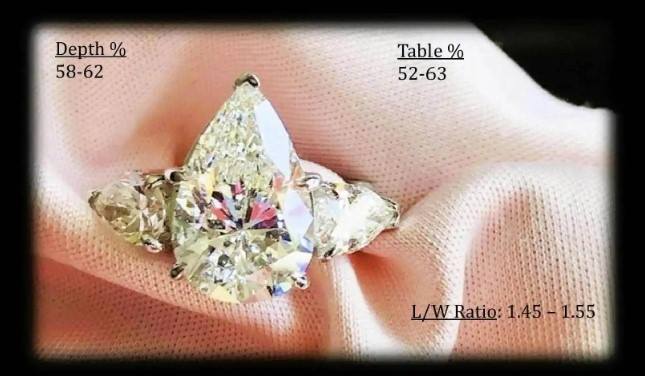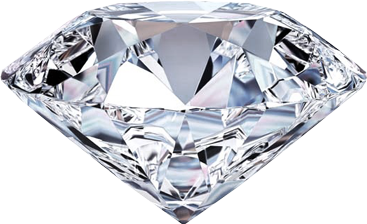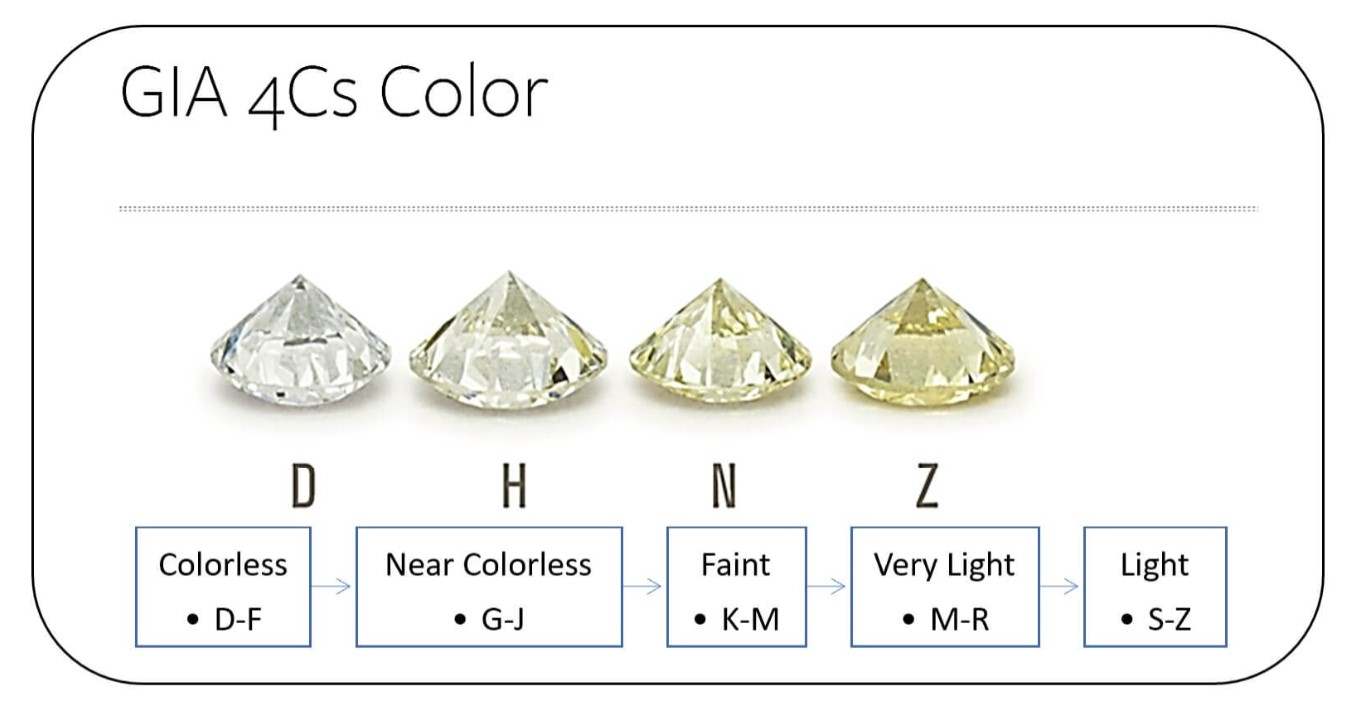Pear Cut Diamonds Guide: L/W Ratio & Ideal Proportions
Pear Cut Diamonds Guide: L/W Ratio & Ideal Proportions
Posted by Sharif Khan on 14th Jun 2022
Pear Cut Diamonds

The shape of a brilliantly cut pear diamond is developed by combining the style and brilliance of both round and marquise cut diamonds. Since they have a big spread, such as an oval or marquise cut diamond, pear cut diamonds have a large surface size.
Pear cut diamonds are popular and in high demand among our customers looking for something unique and different. When buyers inquire about a pear cut diamond, they are confident about the shape and why they want to buy it.
Key Points to Know
- Buy a pear cut diamond with a length-to-width ratio of 1.45 to 1.155, depth of 58 to 62%, and table of 52 to 63%.
- Make sure the stone comes with a GIA grading report.
- Avoiding fluorescence in D to G color pear cut diamonds is recommended.
- Search & Watch Diamonds in SUPER HD 360 DEGREES.
When prioritizing the 4Cs, here are four scenarios to consider:
- Scenario 1: Investment Grade, D/E-Fl/VVS range (see EXAMPLE).
- Scenario 2: Best Value and Quality, F/G-VS/SI1 range (see EXAMPLE).
- Scenario 3: Best Value and Decent Quality, H/I-SI range (see EXAMPLE).
- Scenario 4: Color Compromised, Best Other 3Cs, L/M-VS+ range (see EXAMPLE).

Pear Cut Diamonds Highlights
| Shape |
Pear cut diamonds are among the most popular diamond shapes and are becoming highly sought-after stones. While carat weight depends on a buyer's budget, the one-carat+ range is a good choice. |
| Cut | 55-65% depth and 52-63% table are in the excellent range. See the cut chart below carefully for more details. |
| L/W | The 1.4-1.55 range is ideal for the length-to-width ratio, depending on a buyer's preference. |
| Color | In terms of color, G or above is excellent. However, up to J color is fine if you have budget constraints. |
| Clarity | In terms of clarity, SI1 is fine for under 1 carat. For above 1ct., go for VS2 or above. |
| Certification | We recommend that all diamonds be graded by the GIA or AGS — two of the best diamond certification labs in the world. Review the section below on how to read a grading report carefully. |
| Fluorescence | In terms of fluorescence, medium blue fluorescence is fine in H-J color diamonds, though we recommend avoiding it in D to G colors. |
| Settings | Check our list of unique pear diamond engagement rings for reference. |
| Best Places | Here is a list of the best places to buy diamonds. |
Ideal Proportions for Pear Cut Diamonds
Understanding how to assess the cut of pear shaped diamonds is crucial because GIA does not assign a cut grade to them, and only polish and symmetry are not enough to assess their cut.
Depth, table, and length-to-width ratios are the most crucial factors when analyzing the cut grade of a pear shape diamond. The thickness of the girdle also bears importance.
James Allen has the most advanced technology for viewing diamonds, including 40X Magnification and 3D Technology WITH 360 DEGREE ANGLES. Compare pear cut diamonds with this technology to avoid the bow-tie effect, and pick a well-cut pear diamond.
|
Depth%
Excellent: 58 - 62 Very Good: 56 - 58-62 - 66 Good: 53 - 56/66 – 71 Fair: 50 – 53/71 - 74 Poor: <50 or >74 |
Table%
Excellent: 52-63 Very Good: 64 - 65 Good: 51/66-68 Fair: 50/69-70 Poor: <50 or >70 |
|
L/W Ratio
Excellent: 1.45 – 1.55 Very Good: 1.40-1.45/1.56-1.65 Good: 1.35-1.4/1.66-1.80 Fair: 1.25-1.34/1.81-2.00 Poor: >1.25 - <2.00 |
Girdle
Excellent: Very Thin-Slightly Thick/Thin-Thick Very Good: Very Thin-Slightly Thick/Thin-Thick Good: Very Thin-Thick Fair: Very Thin-Very Thick Poor: Extremely Thin-Extremely Thick |
|
Culet
Excellent: None Very Good: Very Small Good: Small Fair: Medium Poor: Medium |
Fluorescence
None, Excellent Faint, V. Good Medium Blue, Good Strong Blue, Fair Very Strong Blue, Poor |
Clarity in Pear Cut Diamonds
The problem of clarity is the same in all diamonds. Inclusions can be visible to the naked eye in SI2 or below clarity grades, affecting their brilliance and fire.
So, what should buyers look out for in terms of diamond clarity? We suggest that buyers focus on two factors:
First, determine what they can afford; based on that, determine the appropriate clarity grade. Going for the highest clarity grade (flawless) is not critical since VVS/VS1 grades are also great options. Given that inclusions are natural birthmarks of a diamond, sometimes dealers prefer a VVS clarity over flawless or internally flawless because it is one way to distinguish a natural diamond from a moissanite. However, lab-grown diamonds also have inclusions.
If you are on a budget, an SI2 or above clarity grade is fine for diamonds in the 1 carat range if the diamond is eye-clean to the naked eye. Avoiding large inclusions on the table is important; ensure they are not heavy black crystals. We generally prefer diamonds with a clear table and slight inclusions spread out across the diamond.
Second, balance clarity with the other 3Cs of the diamond, such as carat weight, color, and cut. For example, getting a VVS diamond with a smaller carat and a bad color and cut would be unwise. Sometimes, a 0.7ct diamond will look as big as a 1 carat if the latter is cut shallowly to save more weight, compromising its cut quality.
Use the following chart as a general guideline when selecting the clarity grade of a pear cut diamond based on its carat weight:
|
<0.5 Carat Poor/Fair: >I1/ I1 Good: SI2 Very Good: SI1-VS2 Excellent: FL-VS1 |
0.51 – 1.0 Carat Poor/Fair: > I1 Good: SI2 Very Good: SI1-VS2 Excellent: FL-VS1 |
|
1.0 – 2.0 Carat Poor/Fair: >I1 Good: SI2-SI1 Very Good: VS2 Excellent: FL-VS1 |
>2.0 Carat Poor/Fair: >I1 Good: SI2-SI1 Very Good: VS1-VS2 Excellent: FL-WS2 |
Color in Pear Cut Diamonds
Like clarity, color is the same in all shapes of diamonds. In terms of importance, it comes second after the cut. However, color affects the overall appearance, unlike clarity, which affects one specific spot.
In a nutshell, buyers should focus on two essential points:
First, decide what you can afford. Consider the highest color grades—D or E with no fluorescence. However, G-J colors are considered near colorless and could be good for individuals on a budget. Here, our optimal color ranges are G/H or, at most, I color. Medium blue fluorescence is a good ally in H-J color diamonds. Because fluorescence is blue, which complements yellow, it usually makes slightly tinted diamonds appear whiter.
Second, balance the color with the other 3Cs—clarity, carat weight, and cut. While it is the second most important C, one should not compromise heavily on clarity, carat weight, and most definitely not on cut to get a better color diamond.
The table below could be helpful for an in-depth examination of color in pear cut diamonds.
|
< 0.50 Carat Poor/Far: >M/ L-M Good: I-K Very Good: G-I Excellent: D-G |
0.51 – 1.0 Carat Poor/Fair: J-K / >L Good: I Very Good: H Excellent: D-G |
|
1.0 – 2.0 Carat Poor/Fair: >J Good: I/H Very Good: G Excellent: D-F |
>2.0 Carat Poor/Fair: >J Good: H-I Very Good: F-G Excellent: D-E |
|
Fluorescence Poor/Fair: Strong Good: Medium Very Good: Faint Excellent: None |
|
Fluorescence in Pear Cut Diamonds
The presence of fluorescence affects the price of a diamond, although it can be advantageous for individuals with budget constraints. While it does not significantly affect the brilliance of a diamond in most cases, we recommend avoiding it in D-G color diamonds. The boundary line is G color, where it is neutral, and in H and above color diamonds, up to medium blue fluorescence can be a plus, as it can make the diamond appear whiter, given that blue is a complementary color to yellow.
Diamond BGM
This is a technical term in the industry, and most consumers are unaware of it. It is also not specified in a GIA report, so you will not know. BGM stands for Brown, Green, and Milky. These are shades that some diamonds, regardless of their clarity or color, would have and can affect their brilliance and fire. Ask your dealer to inspect the stone and ensure it has no BGM. Most dealers care about their clients and will make sure they get a good stone.
Reading A Pear Cut Grading Report
Beyond the widely recognized 4Cs, buyers must acquaint themselves with the critical facets of an pear cut diamond grading report or certificate, as highlighted in the image below.

Watch the HD VIDEO of this Diamond.
Measurements: This aspect holds significant importance as it provides the buyer with information regarding the diamond's surface size, indicating its apparent size in millimeters. Furthermore, it offers the length-to-width ratio by dividing the length by the width (in the case above, resulting in a ratio of 9.71/6.19=1.56).
Fluorescence: This should be regarded as the 5th C. Given the diamond's E color grade, avoiding fluorescence is the optimal choice in this example. However, medium blue fluorescence is not as concerning as strong blue fluorescence.
Comments: This section will display factors pertinent to clarity and highlight whether a diamond has undergone clarity enhancement, utilizing methods such as laser drilling or color enhancement. Additionally, pay attention to comments like "clarity grade based on clouds," which is a worrisome indicator within clarity grades of VS2 and below. The laser inscription of the report number on the girdle is positioned above the comments section (an optional service for added verification).
Proportions: This chart holds paramount importance in assessing the diamond's cut. Specifically, focus on the table percentage (64% in the provided example - excellent), depth percentage (63.2% - excellent), girdle (thick to very thick- very good), and culet (none - excellent).
Clarity Characteristics: This section will indicate the types of inclusions and their respective locations. It proves invaluable for buyers seeking to avoid diamonds with conspicuous inclusions at the center. Furthermore, these details help correlate the report with the diamond, as these inclusions are the diamond's distinctive birthmarks.
4Cs Prioritization in Pear Cut
Over the last decade, our clients often considered the following four scenarios as they prioritized the 4Cs and determined the best diamond within their budget.

Scenario 1: Shoppers aim for the highest quality diamond possible within a carat range; we refer to these as "investment-grade diamonds" because of their rarity. In this range, shoppers often opt for D-E color diamonds, flawless VVS clarity, and excellent cuts with no fluorescence.
Scenario 2: This is our favorite scenario because buyers in this category often take a balanced approach, meaning they do not overly compromise on one C to maximize another. Diamonds in this category still fall within the investment-grade range. The best options under this category are FL-VS2 or even eye-clean SI1 clarity, F-H color, and excellent to very good cut diamonds with ideal proportions and no to medium blue fluorescence.
Scenario 3: Shoppers often do not mind compromising on the other 3Cs to get a bigger diamond. However, they still want the stone to be eye-clean with optimal brilliance. Hence, they would go for a 2 carat, SI1 clarity, I/J color diamond with a good to very good cut instead of a 1.5 carat, G color, VS2, and ideal cut diamond.
Scenario 4: The shopper often knows that to get a large stone within their budget, they have to compromise on one C to maximize the other 3Cs. In this scenario, we recommend compromising on color and maximizing carat weight, clarity and cut.
Final Thoughts
As a rule of thumb, ensure you have covered the seven most important factors when buying a pear cut diamond: shape, carat weight, cut, color, clarity, certification, and fluorescence. We also recommend that buyers balance the 4Cs proportionally. Finally, purchasing a diamond graded by GIA is the safest approach, given they are highly consistent in terms of grading diamonds.
It is also advisable to have a strong return policy when shopping for loose GIA certified diamonds. In our experience, buyers should have answers to the following questions at a minimum before buying a diamond:
- Is it a reliable brand/reputable company?
- Do they offer a lifetime service plan?
- Do they provide fair lifetime upgrade options?
- Do they accept returns for a full refund?






